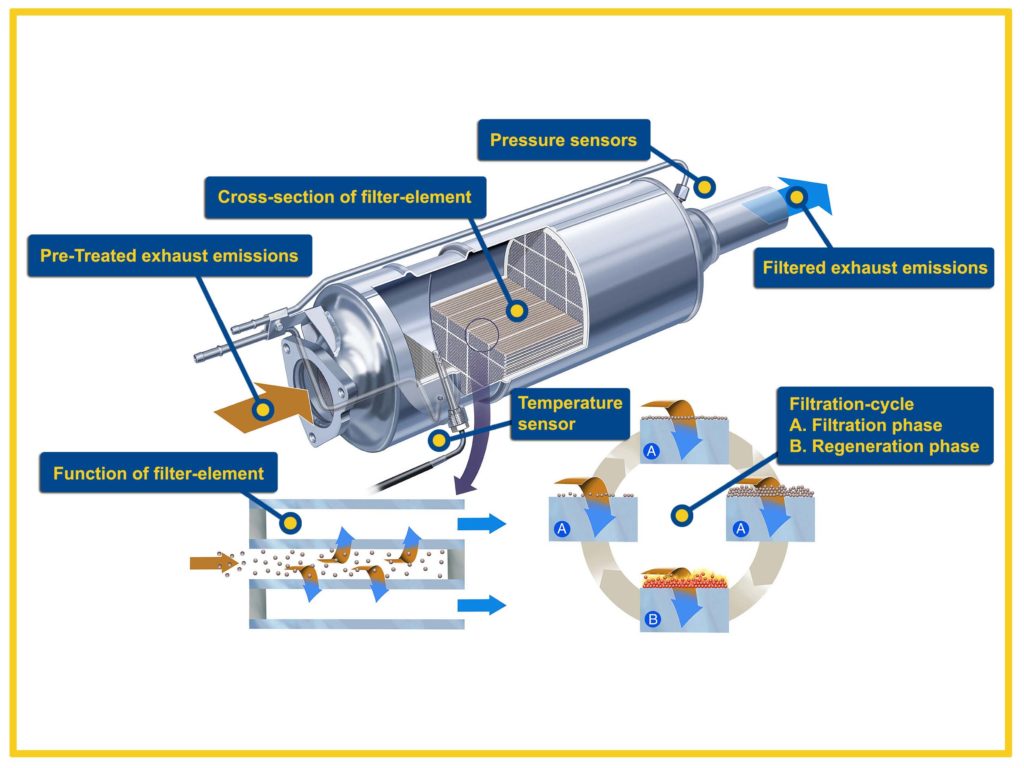Diesel Particulate Filter and how it operates?
Diesel emissions are 90% lower since the 1980s; however exhaust regulations based on statistical studies dealing with the health impact of exhaust emissions continue to demand even lower gaseous and particulate diesel emissions. Particulate emissions are responsible for the characteristic black exhaust fumes emitted from the diesel engine. They are a complex mixture of solid and liquid components with the majority of particulates being carbon micro spheres on which hydrocarbons from the engines fuel and lubricant condense.
In order to comply with the strict European Stage IV emission standard, which now requires a further 50% reduction in particulate emissions, an exhaust emission control system is used on the XJ 2.7 liter and S-TYPE 2.7 litre diesel vehicles. The primary component of the system is the diesel particulate filter (DPF), which has been proven to be effective in reducing particulate emissions to negligible levels. The main ability of the particulate filter is its capacity for regeneration; that is burning the particulates trapped in the filter at calculated intervals in such a way that the process is unnoticed by the driver of the vehicle.
The inner workings of DPF
To enable the exhaust emission control system to store and when conditions determine, burn the particulates, the diesel particulate filter uses new filter technology based on a filter with a catalytic coating. Made of silicon carbide the filter is packaged into a steel container installed in the exhaust system of the vehicle. The filter has good thermal shock resistance and thermal conductivity properties, plus a closely controlled porosity. The filter is tailored to the engines requirements to maintain the most favorable exhaust backpressure.
The porous substrate in the filters interior consists of thousands of small parallel channels running in the exhausts longitudinal direction, adjacent channels in the filter are alternately plugged at each end. This arrangement forces the exhaust gases to flow through the porous walls, which acts as the filters medium. Particulates that are too big to pass through the porous walls are left behind and stored in the channels. To prevent the particulates creating an obstruction to the exhaust gas flow, the filter system provides a regeneration mechanism, which involves raising the temperature of the filter to such an extent that the particulates are incinerated and as a result removed from the filter.
The most important parameters influencing filter regeneration is the temperature of the exhaust gases and filter. With this in mind the composition of the filter also includes a wash coating to the surface of the filter comprising platinum and other active components; materials used in the manufacture of oxidation catalytic converters. At certain exhaust gas and filter temperatures the catalytic coating promotes combustion and therefore burning of the particulates, while also oxidizing carbon monoxide and hydrocarbon emissions.
Exhaust gas and filter temperatures are controlled by the diesel particulate filter (DPF) module, which is incorporated in the powertrain control module (PCM). The DPF module monitors the load status of the particulate filter based on driving style, distance driven, and signals from the differential pressure sensor. When the particulate loading in the filter reaches a threshold, the filter is actively regenerated by adjusting, in accordance with requirements various engine-control functions; such as: fuel injection, intake-air throttle, glow-plug activation, exhaust-gas re circulation, and boost-pressure control.
This control function is made possible by the flexibility of the common-rail fuel injection engine in providing the precise control of: fuel-flow, fuel pressure, and injection timing, all essential requirements for an efficient regeneration process.
Engine Oil Dilution
A disadvantage of active regeneration is engine oil dilution caused by small amounts of fuel entering the engine crankcase during the post-injection phases. This has made it necessary, in some circumstances to reduce the oil service intervals. The driver of the vehicle is alerted to this by the instrument-cluster message center.
An algorithm programmed in the DPF module monitors driving style, active regeneration frequency and duration. Using this information the module predicts the level of oil dilution. When the oil dilution level reaches a threshold value (the fuel being 7% of engine oil volume), a red warning lamp and ‘Service required’ message is displayed.
Depending on driving style, a small percentage of vehicles will require an oil change before the standard 15,000 miles service interval. If an engine oil dilution event does occur the vehicle will undergo its full service and the service mileage counter will be reset to zero by the service technician. Refer to GTR for further information on resetting the service mileage counter.
Fuel Consumptio
There will be a small increase in fuel consumption due to active regeneration of the particulate filter.
During regeneration the fuel consumption approximately doubles. However, because regeneration happens relatively infrequently the overall increase in fuel consumption is small. This is accounted for in both the instantaneous and average fuel economy displayed in the instrument cluster.
Article Ref: Honest John
Tags: dpf cleaning, dpf delete, dpf filter, dpf problems, dpf regeneration, dpf removal, dpf replacement, dpf services, dpf solution




